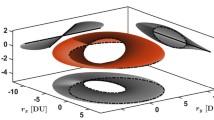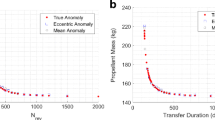Abstract
A direct optimization method has been developed and utilized to compute a wide range of optimal low-thrust interplanetary trajectories. This method replaces the optimal control problem with a nonlinear programming problem which in turn is solved by using sequential quadratic programming. The direct approach is capable of modeling multiple powered and coast arcs, planetary gravity assists, and constant-thrust and variable-thrust electric propulsion systems. The advantages of the direct approach include reduction in the design space, ease of establishing good initial guesses for the design parameters, and improved flexibility for handling “mixed” optimal control problems with continuous control functions and discrete control parameters. Numerical results are presented for three interplanetary mission examples and the results from the direct method show an excellent match with published optimal trajectories. In addition, optimal trajectories are obtained for a new low-thrust interstellar transfer problem.
Similar content being viewed by others
References
RAYMAN, M. D., and LEHMAN, D. H. “NASA’s First New Millennium Deep-Space Technology Validation Flight,” Paper No. IAA-L-0502, Second IAA International Conference on Low-Cost Interplanetary Missions, Laurel, Maryland, April 1996.
HACK, K. J., GEORGE, J.A., and DUDZINSKI, L. A. “Nuclear Electric Propulsion Mission Performance for Fast Piloted Mars Missions,” Paper No. 91-3488, AIAA/NASA/OAI Conference on Advanced SEI Technologies, Cleveland, Ohio, September 1991.
KELLEY, J. H., and YEN, C. L. “Planetary Mission Opportunities with Nuclear Electric Propulsion,” Paper No. 92–1560, AIAA Space Programs and Technologies Conference, Huntsville, Alabama, March 1992.
COVERSTONE-CARROLL, V., and WILLIAMS, S. N. “Optimal Low Thrust Trajectories Using Differential Inclusion Concepts,” Journal of the Astronautical Sciences, Vol. 42, No. 4, 1994, pp. 379–393.
TANG, S., and CONWAY, B. A. “Optimization of Low-Thrust Interplanetary Trajectories Using Collocation and Nonlinear Programming,” Journal of Guidance, Control, and Dynamics, Vol. 18, No. 3, 1995, pp. 599–604.
BETTS, J. T. “Optimal Interplanetary Orbit Transfers by Direct Transcription,” Journal of the Astronautical Sciences, Vol. 42, No. 3, 1994, pp. 247–268.
PIERSON, B. L. “Sequential Quadratic Programming and Its Use in Optimal Control Model Comparisons,” Optimal Control Theory and Economic Analysis, Vol. 3, Elsevier Science Publishers, Amsterdam, 1988, pp. 175–193.
POULIOT, M. R. “CONOPT2: A Rapidly Convergent Constrained Trajectory Optimization Program for TRAJEX,” GDC-SP-82-008, General Dynamics, Convair Division, San Diego, California, January 1982.
MEWALDT, R. A., KANGAS, J., KERRIDGE, S. J., and NEUGEBAUER, M. “A Small Interstellar Probe to the Heliospheric Boundary and Interstellar Space,” Acta Astronautica, Vol. 35, Suppl., 1994, pp. 267–276.
GILLAND, J. H. “Mission and System Optimization of Nuclear Electric Propulsion Vehicles for Lunar and Mars Missions,” NASA CR-189058, NASA Lewis Research Center, Cleveland, Ohio, December 1991.
Author information
Authors and Affiliations
Rights and permissions
About this article
Cite this article
Kluever, C.A. Optimal Low-Thrust Interplanetary Trajectories by Direct Method Techniques. J of Astronaut Sci 45, 247–262 (1997). https://doi.org/10.1007/BF03546403
Published:
Issue Date:
DOI: https://doi.org/10.1007/BF03546403




